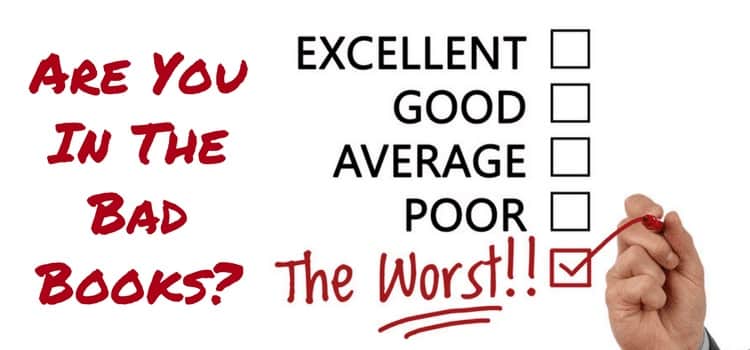
In all forms of publishing, only a tiny percentage of books sell well. Some do okay and are followed then by a lot of books that fail badly.
It has always been the ratio of success in publishing.
There are a few winners but a lot of losers. It is why book publishing is a gamble.
No matter who or how a book is published, you can end up in the bad books.
Why do books fail?
One of the most difficult decisions for self-published authors is to admit that one of their books is a bad book.
There can be many reasons why a book fails.
But trying to pinpoint them for your book, which you love, is difficult.
It took me many years to understand this fact.
No matter what I thought about my books, the only opinion that counted was the reader’s opinion.
When I finally stood back from my thoughts and concentrated on what readers thought about my books, I came up with three groupings for a book that was not doing very well.
They fall into three categories; liked, disliked, and ignored.
All authors would prefer their books to be in the first category.
But the reality is that even with a lot of hard work and effort, it is difficult to achieve a runaway bestseller every time.
So what can you do?
1. Your book is liked
These are the books that, while probably not necessarily bestsellers, sell consistently, attract positive reviews, and usually do well on promotion.
For books in this category, I often believe that doing little is the best thing to do.
While there will always be an odd negative review, the consistency of sales is important.
Even if it is only 10-20 sales a month, something is attracting buyers.
I wouldn’t change too much apart from trying a new cover or editing the book description.
Sure, it may never sell better than it is doing.
But it is a book that can only help enhance your reputation as a writer by collecting mainly positive reviews.
2. Readers dislike your book
When you have a book that collects a long list of negative reviews, there are two ways of looking at it.
One is that it could be a horrid book.
The other is that there must be something about the book that is attracting people to it.
Otherwise, it wouldn’t be getting reviews.
Another odd fact is that books that get a lot of reviews, even awful ones, increase in sales ranking due to the number of reviews.
But, there is urgent work to do with a book such as this.
Believe it or not, it has the potential to be a good seller.
The first task is to analyze the reviews and look for common factors that have been criticized.
If you can address these issues with a rewrite or, perhaps better, with the help of a complete edit and proofread to overcome the weaknesses, the book stands a good chance of success.
The second task is not so easy.
Find the positives.
Try to look at what has made the book attract so much interest.
Perhaps it was the cover or the book description. More likely, that the first few pages appearing in the book’s preview were well written.
But later in the book, the writing standard fell apart, or the story lost its way.
With work, a disliked book has a lot of potential. Don’t waste the opportunity.
3. People ignored your book
These books are the ones that attract no interest at all, let alone sales, and also probably fail when you offer them for free.
There could be many reasons. But most likely, it has a weak or unattractive plot that the book description can’t even spin into something interesting.
Other reasons could include having an awful cover, a poor book description, being listed in an inappropriate category, or possibly, that the beginning of the book is spoiling what may be a more interesting story later in the book.
For whatever reason, a book such as this is a prime candidate to be unpublished and removed from sale. It can only hurt an author’s reputation.
Sure, you can try remedial work.
But there are times when it is best to stop wasting a lot of time trying to revive a failing book and spend the time more productively on writing a new book.
Having written many books now, I can tell you that I have had my fair share in each category.
Yet, no matter how much thought I have given to a book before release, I never know in which category it will go once readers have their say.
Some have been a surprise and were liked, even though I wasn’t sure about them. Whereas others, which I loved writing, have flopped into the ignored pile.
Two of my books, which sell moderately yet consistently well, were initially disliked when first published.
But after complete revisions and republishing, they then performed much better.
Summary
There are now over 6 million ebooks on Kindle and 53 million books in total on Amazon, so competition is not getting any easier.
It’s essential, especially now that paid promotion is becoming a regular part of book promotion for self-publishers, that you don’t waste money on books that will never be winners.
No matter how much time and money you spend, a bad book will never sell.
Find your liked books and promote them.
But don’t waste your money on the disliked and ignored until you have at least taken some action to help their chances.
Books are always a gamble once they hit the market.
That’s the nature of the publishing business.
So take the good with the bad, but above all else, never give up and never give up writing.
The adage, write a better book, is very true.
Your next, as yet unwritten book could be one that readers love.
Related Reading: How To Publish A Book The Right Way To Reach More Readers




These are not types of books but ratings or opinions of books. Every writer and reader already knows that there are good books, bad books and forgettable books. Don’t pander to us, teach us something. What genres work out don’t work? What premises are so outdated that no one wants to read them? What demographic does the writer’s chosen genre attract? This read like click bait: a catchy title but no real substance it information of use.